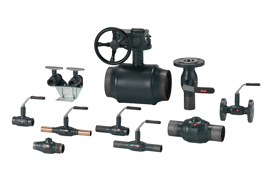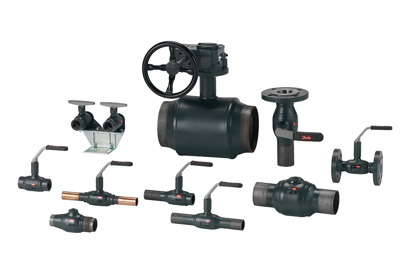So far, 70% of all buildings in the city have been connected to the district heating system and the network is gradually being optimized. In the near future, two hospitals, one of them a big regional center, will be connected as well.
The city council has decided to improve the energy efficiency over 5 years. "We therefore also optimize the software (Termis), by using the Danish company 7 Technologies. Their software optimizes the operation of our district heating network. By connecting their software to SCADA, we can predict and optimize the consumption and in this way improve the efficiency a lot”, says Amer Karabegovic, development manager at the Tuzla district heating company, Centralno Grijanje.
Amer Karabegovic is satisfied. From being a city with a high level of air pollution due to individual heating by the use of brown coal and oil, Tuzla has gradually enlarged its district heating network. At the same time, the existing system has undergone major modernizations to make the city much more energy efficient today than it was 5 years ago. “Individual heating by the use of brown coal is stinky and unhealthy, so we have been working hard on replacing such ways of heating with district heating. And we make good progress. The only big brown coal users left are now the Dragodol area and the city’s two hospitals. We will connect these in 2010”, Amer Karabegovic says. He is development department manager at the Tuzla district heating company, called Centralno Grijanje Tuzla. 550 substations are now installed in buildings around Tuzla, app. 300 of them are compact stations. More than 200 of these are from Danfoss. Big substations (195 - 1200 kW) are supplying tall blocks of flats, others (60 - 190 kW) are supplying small and medium-sized buildings and finally a small type of substation (20 - 55 kW) is used for individual houses. 150 km of pipeline is ensuring that surplus heat from the coal-fired Tuzla Power Plant reaches the customers.
Immense improvements
Amer Karabegovic and his colleague Esad Trumic, director of distribution at Centralno Grijanje, take us on a little tour around the city. In a 15-story building, that used to be heated by a rather ineffective heating system, a new substation from Danfoss has been installed in a small boiler room in the basement “Our rule is that every building must have its own substation. In that way consumers get a more stable heat supply and they get a much more comfortable temperature level. Before, the residents had overheated apartments in the winter - often 28 degrees, which is much too warm - and therefore they opened the windows to bring down the temperature. A terrible waste of energy! Now they have 22 degrees. It is still too high, but much better than before, and the residents are really happy”, Amer Karabegovic explains. “However, there are no flat stations in the building, so the residents still cannot regulate the system temperature themselves. Therefore there is still room for improvements”, adds Esad Trumic, the director of distribution. Moreover, the substation does not handle domestic hot water. There were no pipes built for hot water when the building was constructed. Instead residents get hot water through an individual boiler running on electricity, which is not the most energy efficient system. “Still, the improvement in a building like this is immense. The quality of life is higher than before and the energy bill is lower. Furthermore, the district heating company, owned by the city of Tuzla, saves a lot of money, which can be invested in other improvements. The company is the main contributor to making the city more energy efficient”, Kemal Lojo, project manager from Danfoss Croatia says. He has joined us in Tuzla, since Danfoss Croatia is tending the Bosnia-Herzegovian market as well.
Computerized monitoring system
Many of the 550 substations in the city system are indirect substations with multiple heat exchangers and with less regulation from primary side. But today the district heating company is only implementing compact heating substations with full regulation of temperature and flow on primary side and also with regulation on the secondary side. This saves energy. Approximately, it decreases the consumption in buildings like this with 20-30 %. Another energy saving tool is the SCADA system, which 36 substations are connected to by the use of remote control. “We control all data from this building on our computer screen. We can remotely control all parameters in the building and control how temperatures are going up and down in the substation. The city council has decided to improve the energy efficiency over 5 years. We therefore also optimize the software (Termis), by using the Danish company 7 Technologies. Their software optimizes the operation of our district heating network. By connecting their software to SCADA, we can predict and optimize the consumption and in this way improve the efficiency a lot”, Amer Karabegovic says.
Pazar area connected
A central area of Tuzla, the Pazar area, was not connected to district heating during the Yugoslavia regime. Only larger houses were connected, whereas the 12-unit apartment building we visit here in Pazar was connected for the first time in 2009. The area only consists of single-family houses and smaller apartment buildings which had to manage with individual heating. The 90 kW substation supplies all 12 apartments with heating. Like in the 15-story building we visited before, the residents pay the bill according to the number of square meters, since there are no flat stations with heat meters in each individual apartment. An employee from Centralno Grijanje shows us the substation in the basement. Once a day,he checks and notes down data of consumption and of variations in temperature between the substation and the building. “This substation will not be connected to the SCADA system, but we want to follow very carefully how the building reacts now when district heating is installed. It gives us know-how which can be used in future projects”, Amer Karabegovic says.
Related products
-
if (isSmallPicture) {


 Electronic temperature control
Electronic temperature controlDanfoss offers a complete system for monitoring and optimizing any commercial refrigeration solution, such as for instance glass door merchandisers, air dryers, cold rooms, trucks and trailers.
-
if (isSmallPicture) {


 Ball valves
Ball valvesBall valves enable on/off control of the building system connection. They create the sectioning of the system that enables service, maintenance and repairs to be carried out in sections, without shutting down or emptying the whole system.






